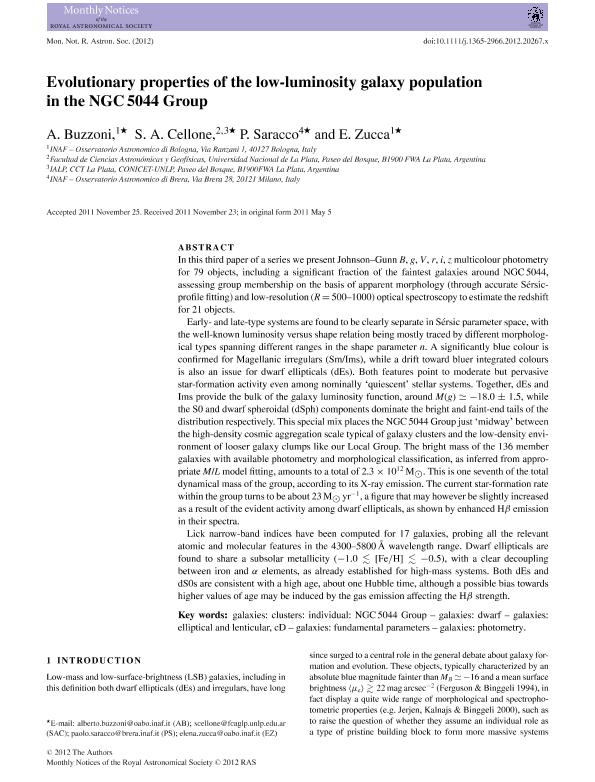Mostrar el registro sencillo del ítem
dc.contributor.author
Buzzoni, A.
dc.contributor.author
Cellone, Sergio Aldo

dc.contributor.author
Saracco, P.
dc.contributor.author
Zucca, E.
dc.date.available
2019-08-29T20:20:36Z
dc.date.issued
2012-03
dc.identifier.citation
Buzzoni, A.; Cellone, Sergio Aldo; Saracco, P.; Zucca, E.; Evolutionary properties of the low-luminosity galaxy population in the NGC5044 Group; Wiley Blackwell Publishing, Inc; Monthly Notices of the Royal Astronomical Society; 420; 4; 3-2012; 3427-3450
dc.identifier.issn
0035-8711
dc.identifier.uri
http://hdl.handle.net/11336/82530
dc.description.abstract
In this third paper of a series we present Johnson-Gunn B, g, V, r, i, z multicolour photometry for 79 objects, including a significant fraction of the faintest galaxies around NGC5044, assessing group membership on the basis of apparent morphology (through accurate Sérsic-profile fitting) and low-resolution (R= 500-1000) optical spectroscopy to estimate the redshift for 21 objects. Early- and late-type systems are found to be clearly separate in Sérsic parameter space, with the well-known luminosity versus shape relation being mostly traced by different morphological types spanning different ranges in the shape parameter n. A significantly blue colour is confirmed for Magellanic irregulars (Sm/Ims), while a drift toward bluer integrated colours is also an issue for dwarf ellipticals (dEs). Both features point to moderate but pervasive star-formation activity even among nominally 'quiescent' stellar systems. Together, dEs and Ims provide the bulk of the galaxy luminosity function, around M(g) ≃-18.0 ± 1.5, while the S0 and dwarf spheroidal (dSph) components dominate the bright and faint-end tails of the distribution respectively. This special mix places the NGC5044 Group just 'midway' between the high-density cosmic aggregation scale typical of galaxy clusters and the low-density environment of looser galaxy clumps like our Local Group. The bright mass of the 136 member galaxies with available photometry and morphological classification, as inferred from appropriate M/L model fitting, amounts to a total of 2.3 × 10 12M ⊙. This is one seventh of the total dynamical mass of the group, according to its X-ray emission. The current star-formation rate within the group turns to be about 23M ⊙yr -1, a figure that may however be slightly increased as a result of the evident activity among dwarf ellipticals, as shown by enhanced Hβ emission in their spectra. Lick narrow-band indices have been computed for 17 galaxies, probing all the relevant atomic and molecular features in the 4300-5800Å wavelength range. Dwarf ellipticals are found to share a subsolar metallicity (-1.0 ≲ [Fe/H] ≲- 0.5), with a clear decoupling between iron and α elements, as already established for high-mass systems. Both dEs and dS0s are consistent with a high age, about one Hubble time, although a possible bias towards higher values of age may be induced by the gas emission affecting the Hβ strength.
dc.format
application/pdf
dc.language.iso
eng
dc.publisher
Wiley Blackwell Publishing, Inc

dc.rights
info:eu-repo/semantics/openAccess
dc.rights.uri
https://creativecommons.org/licenses/by-nc-sa/2.5/ar/
dc.subject
Galaxies: Clusters: Individual: Ngc5044 Group
dc.subject
Galaxies: Dwarf
dc.subject
Galaxies: Elliptical And Lenticular, Cd
dc.subject
Galaxies: Fundamental Parameters
dc.subject
Galaxies: Photometry
dc.subject.classification
Astronomía

dc.subject.classification
Ciencias Físicas

dc.subject.classification
CIENCIAS NATURALES Y EXACTAS

dc.title
Evolutionary properties of the low-luminosity galaxy population in the NGC5044 Group
dc.type
info:eu-repo/semantics/article
dc.type
info:ar-repo/semantics/artículo
dc.type
info:eu-repo/semantics/publishedVersion
dc.date.updated
2019-08-23T17:42:23Z
dc.journal.volume
420
dc.journal.number
4
dc.journal.pagination
3427-3450
dc.journal.pais
Reino Unido

dc.journal.ciudad
Londres
dc.description.fil
Fil: Buzzoni, A.. Osservatorio Astronomico Di Bologna; Italia
dc.description.fil
Fil: Cellone, Sergio Aldo. Consejo Nacional de Investigaciones Científicas y Técnicas. Centro Científico Tecnológico Conicet - La Plata. Instituto de Astrofísica La Plata. Universidad Nacional de La Plata. Facultad de Ciencias Astronómicas y Geofísicas. Instituto de Astrofísica La Plata; Argentina. Universidad Nacional de La Plata. Facultad de Ciencias Astronómicas y Geofísicas; Argentina
dc.description.fil
Fil: Saracco, P.. Osservatorio Astronomico Di Brera; Italia
dc.description.fil
Fil: Zucca, E.. Osservatorio Astronomico Di Bologna; Italia
dc.journal.title
Monthly Notices of the Royal Astronomical Society

dc.relation.alternativeid
info:eu-repo/semantics/altIdentifier/doi/http://dx.doi.org/10.1111/j.1365-2966.2012.20267.x
dc.relation.alternativeid
info:eu-repo/semantics/altIdentifier/url/https://academic.oup.com/mnras/article/420/4/3427/974288
Archivos asociados
